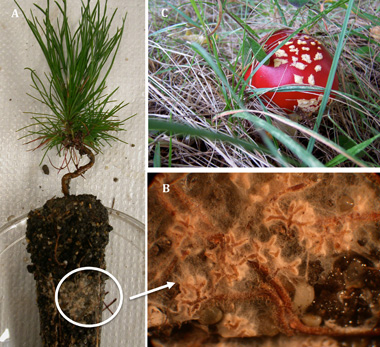WELCOME TO THE DoEd PROJECT
Welcome to the home of the Dimensions of Ectomycorrhizal Diversity (DoED) project!
This project is part of the NSF Dimensions of Biodiversity Program, which aims to foster novel approaches to the understanding of biodiversity on Earth. A main focus of the program is to integrate traditionally separate approaches to studying biodiversity (taxonomic, genetic, and functional) into a synthetic view of diversity. A new understanding of biological diversity is particularly pressing given the large-scale environmental transformations Earth’s ecosystems are currently experiencing.
Fungi are a critical component of the biodiversity and functioning of terrestrial ecosystems. While fungi go largely unseen to the human eye, they play critical roles in the environment. Fungi are the primary degraders of dead plant material, they are major pathogens of living plants and soil animals, and they also form mutually beneficial symbioses with the roots of most plant species, called mycorrhiza (Figure 1). These mutualisms are the primary source of macronutrients (such as Nitrogen & Phosphorous) for most plant species. Ectomycorrhizal fungi, a subset of mycorrhizal fungi, are particularly important for the nutrition of tree species that dominate the temperate forests of North America, such as Pines, Oaks, Willows and Birch.
Like other groups of cryptic, soil dwelling organisms, mycorrhizal communities are hyper-diverse and poorly known in even the best-studied ecosystems. Major advances in molecular biology techniques, such as Next Generation high-throughput DNA sequencing, are just beginning to allow robust exploration of taxonomic diversity in soil communities. However, simple enumeration of species diversity reveals little about the ecological processes structuring communities, or how community structure affects key ecosystem processes.
To begin resolving these important gaps in our fundamental knowledge about a key component of Earth’s ecosystems, this research project will provide the first continental-scale sample linking taxonomic, genetic and functional diversity of ectomycorrhizal fungi in pine ecosystems across North America. Despite the importance of ectomycorrhizal fungi in global nutrient cycles, little is known about large-scale patterns of fungal community structure relative to plants, animals, or even bacteria. This project will establish patterns of gene flow and adaptation for multiple ectomycorrhizal fungi across North America and measure variation in key biochemical characteristics of individuals, populations and species. The project will result in a large, open access database of taxonomic barcode and functional genes that can be used by researchers to generate predictive models of fungal ecosystems.
While this project is still in the early stages of development, we will use this site as a way to update the interested public on progress, publications and datasets generated through our work. Please let us know if you have any comments, questions or suggestions about our work!
*Special thanks to MOBIO & PowerSoil for their support of our project efforts.
Intro to ectomycorrhizal fungi
Mycorrhizal symbiosis is an integral component of forest ecosystems. Most dominant tree species in temperate forests, such as piness (A), depend on fungi for the acquisition of soil nutrients necessary for their growth and reproduction. Plant and fungal tissue intermingle in the roots to form a new absorptive organ – the mycorrhiza. In ectomycorrhizas, fungal tissue entirely encases the plant roots and nutrients are absorbed by hyphal filaments that forage the soil (B). Many of the fungi involved in ectomycorrhizal symbiosis produce conspicuous fruiting bodies, commonly known as mushrooms (C). The genetic and functional diversity of the fungi involved in this symbiosis remains poorly known, but could have important implications for ecosystem health.
